John Wolff's Web Museum
Hewlett-Packard Calculators
This page gives a brief description of some of the early
Hewlett-Packard electronic calculators that have come my way from
sources within Australia.
Detailed technical and historical information on the full range of
Hewlett-Packard machines is available on-line at
The Museum of HP Calculators.
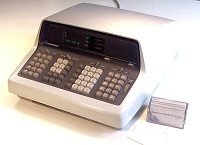 Hewlett-Packard Model 9100B, S/N 0938A03791
Hewlett-Packard Model 9100B, S/N 0938A03791
Functions: Scientific, special functions, 32 memory registers
Programming: All keystrokes, subroutines, 392 steps, magnetic card storage
Technology: Discrete diode-resistor logic, magnetic core memory
Display: 10 significant digits, 2 exponent, 3-register CRT display
Dimensions: 16"W x 19"D x 8-1/2"H, weight 40 pounds
Manufactured: USA, October 1969
The Model 9100 was Hewlett-Packard's first calculator, introduced
in mid-1968. It combined a full range of scientific functions with an
extensive programming capability, including a magnetic card system for
storage of programs and data. The machine was built entirely with
discrete transistors, diode-resistor logic, and magnetic core memory
- there are no integrated circuits.
This remarkable calculator was at least five years ahead of its time,
and served as the benchmark against which all others were judged. Its
price of just under US$5000 was four times the price of a top-line
mechanical calculator, twice the price of most electronic machines, and
more than a year's wages for many people at that time.
The illustration shows the "B" version, with increased memory
capacity. This machine originally belonged to the State Electricity
Commission of Victoria, where it was used for power system calculations
in the engineering departments.
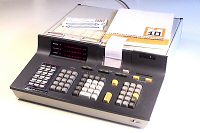 Hewlett-Packard Model 9810, S/N 1228A04915
Hewlett-Packard Model 9810, S/N 1228A04915
Functions: Scientific, plug-in option ROMs, 51 memory registers
Programming: All keystrokes, subroutines, 500 steps, magnetic card storage
Technology: MOS LSI, semiconductor ROM and RAM memory
Display: 10 significant digits, 3-register LED display, internal printer
Dimensions: 17-3/4"W x 21"D x 5-1/2"H, weight 34 pounds
Manufactured: USA, July 1972
HP's second-generation desktop calculators included three quite
different models. The 9810 was basically an "upgrade" of the 9100, the
9820 used an algebraic keyboard language, and the 9830 was programmable
in BASIC. Internally, however, the three machines were very similar. All
were based on a 16-bit serial "mini-computer", built with MOS-LSI
technology and semiconductor memory. The personalities of the different
models were determined by the internal micro-programming, and by changes
to the keyboard and display.
The 9810 had a 3-register display similar to the 9100, but using LED
displays instead of the CRT, and it had an (optional) internal printer.
The basic machine did not include the full complement of scientific
functions, but relied on (optional) plug-in ROM modules to provide a
choice of mathematical, statistical, or other functions. An auxilliary
keypad with interchangeable overlays provided the user interface to the
additional routines in the ROM modules.
This particular machine served for many years as the "office
calculator" for a firm of surveyors in Melbourne, Australia. It came
to me with the printer and mathematical ROMs, the original manuals
and dust cover, and a documented library of survey calculations on
magnetic cards, prepared by the original owners.
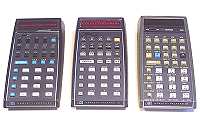 First-generation HP Pocket Calculators
First-generation HP Pocket Calculators
Model 35, 1972
Model 45, 1973
Model 67, 1975, programmable, magnetic card storage
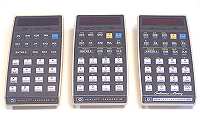 Second-generation HP Pocket Calculators
Second-generation HP Pocket Calculators
Model 21, 1975
Model 25, 1975, programmable
Model 29C, 1975, programmable, "continuous memory"
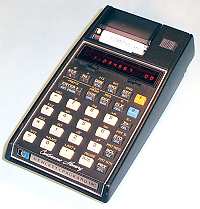 Hewlett-Packard Model 19C, S/N 1802S12751
Hewlett-Packard Model 19C, S/N 1802S12751
Functions: "Pocket" size, scientific, printing
Programming: Keystroke programming, continuous memory
Technology: MOS LSI
Display: 13 digit LED display, internal printer
Dimensions: 3-1/2"W x 6-1/2"D x 1-1/2"H, weight 12oz (incl batteries)
Manufactured: USA, January 1978
The HP Model 19C is a programmable scientific calculator with an
in-built miniature thermal printer. The calculator is functionally
equivalent to the second-generation Model 29C (above), but has been
re-packaged into an older-style case to accommodate the printer and
a 4-cell battery pack.
The printer will record the numerical display, the registers and
stack, or the full program listing on its tiny (1-1/2" wide) paper roll.
Original text and images Copyright (C) John Wolff 2003.
Use at own risk; beware of errors; suggestions for improvement welcome.
Last Updated: 26 June 2003
Back to:
Home
Calculating Machines
 Hewlett-Packard Model 9100B, S/N 0938A03791
Hewlett-Packard Model 9100B, S/N 0938A03791



